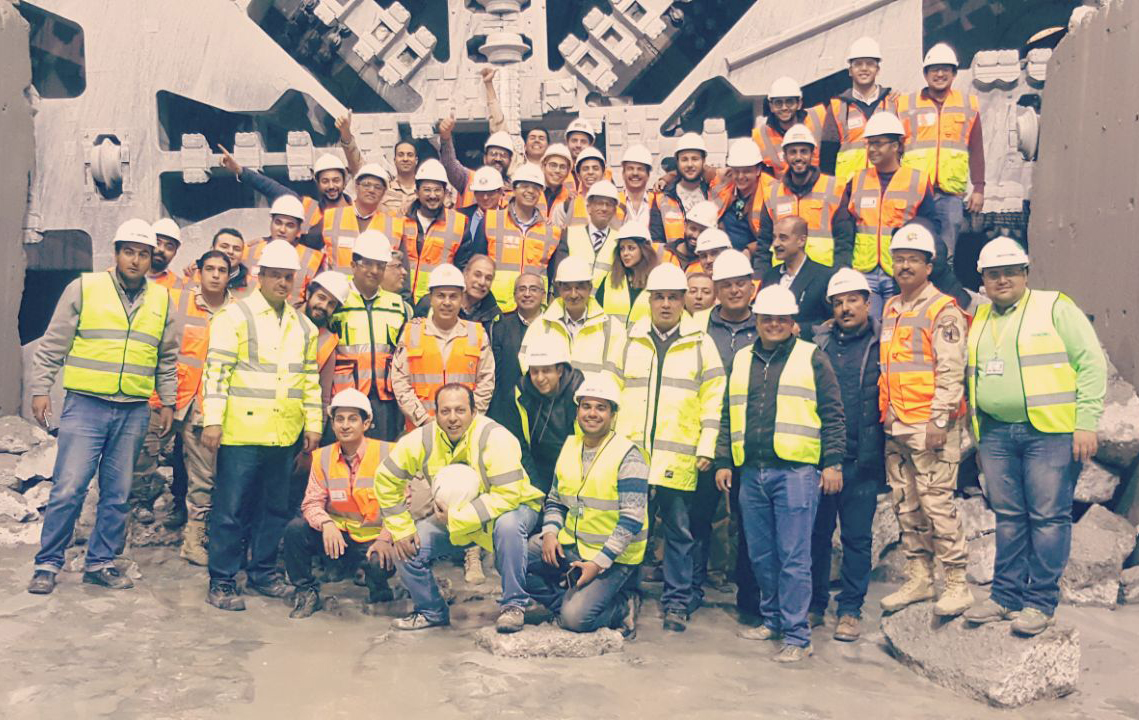Januar 2018
VMT supports the connection of both sides of the New Suez Canal
The New Suez Canal Project in Egypt comprises a new 72 km long canal branch which runs parallel to the existing 190 km long Suez Canal and runs from Deversoir to al-Balah. As part of the new development aimed at bring major economic benefit to this part of the Middle East, four new tunnels are being constructed running beneath the Canal to connect the Sinai Peninsula to the Egyptian mainland.
Two of the tunnels are for road traffic and are located at Port Said and the other two tunnels (also for road traffic) are located in Ismailia, an industrial zone west of the Gulf of Suez.
The road tunnels in Ismailia reach about 50 m depth, over a 4.8 km length with a 10.6 m inner diameter. Each tunnel has two 3.75 m wide lanes for vehicles. Whereas the road tunnels in Port Said have the same geometrical parameters, but being 3.2 km long they are a bit shorter.
 Herrenknecht has provided four TBMs for the construction of the tunnels. Having started the first of the Ismailia tunnels in November 2015, the first TBM recently achieved breakthrough on this 13.05 m diameter, 4,842 m long bore on 3 December 2017. The next TBMs followed in a 1-2 week break through rhythm on 14 December 2017 (S-959), 23 December 2017 (S-960) and the last on 4 January 2018 (S-961).
Herrenknecht has provided four TBMs for the construction of the tunnels. Having started the first of the Ismailia tunnels in November 2015, the first TBM recently achieved breakthrough on this 13.05 m diameter, 4,842 m long bore on 3 December 2017. The next TBMs followed in a 1-2 week break through rhythm on 14 December 2017 (S-959), 23 December 2017 (S-960) and the last on 4 January 2018 (S-961).
The client was the Egypt Armed Forces, with the main construction companies in Ismailia being Petrojet and Concord for the TBM S-958 and TBM S-960 works. The subcontractors for the TBM operation were CMC and Razel. In Port Said the Joint Venture was built by Orascom and Arab Contractors for TBM S-959 and TBM S-961 and the TBM operation was supported by Wayss und Freytag.
At the time of writing, all 4 tunnels are at or near completion in terms of tunnelling but there are still are works on cross-passages, road surfaces and interior construction/fitting-out to be completed.
Supporting the tunnelling process, VMT has provided several of its world-leading tunnelling product lines including:
- A TUnIS Navigation TBMLaser Navigation System
- An IRIS.tunnel Information System with an additional local server now also known as the VDMS system which is the new successor to the IRIS system
- Segment Documentation System SDS, modular production and logistics management system, with the modules SDS-STATIONARY.Professional, SDS.STORAGE.Managed, SDS-Onsite and SDS.TBM
- A system for data, video, telephone, mobile and Wi-Fi site infrastructure management
- A Laser Tracker Industrial Measurement System LIS for segment and mould measurements to validate and control tolerances and quality
Special thanks were given to the VMT site team by VMT’s project engineer, Robert Schuppenhauer, for their work on installation of these systems and their patient support of the jobsite during the advance phase to the successful breakthrough. In particular, thanks go to Hassan Abourrig and Peter Bläsi for their work on the TUnIS Navigation TBMLaser; Steffen Belz and Norbert Bittmann for their work with the Segment Documentation System SDS and Jochen Kauselmann for his work on the IRIS system.
